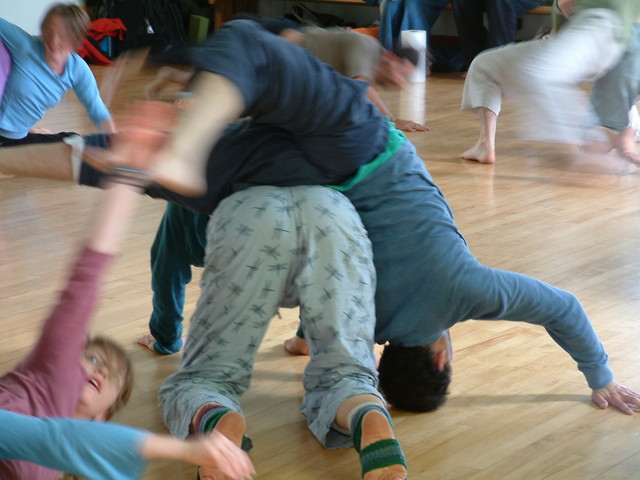 More Than Contact
More Than ContactBy Kim Schoenhaar, 2006
| SUNDAY 6:30-8:30 | WEDNESDAY 7:15-9:15 | ||||
| ***suspended for summer*** | at Main Street Yoga | ||||
| 16 N. Hancock St., Madison, WI | 1882 E. Main St., Madison, WI | ||||
| $5.00 donation requested. | $5-10 donation requested. |
All photos by Nataraj Hauser(c) unless otherwise noted.
Feature
 More Than Contact
More Than Contact
By Kim Schoenhaar, 2006
Arousing, stimulating, undulating, intoxicating
Nerve racking, gut twisting, bone crushing, mind bending
Movement.
I’m told to touch
Touch what?
Touch how?
It helps to respond
And when you get in that groove
There’s nothing else like it.
Only a lover of dance
Can know it.
With another dance lover.
Safe sensuality.
In a roomful of strangers.
Clothed orgy on the floor
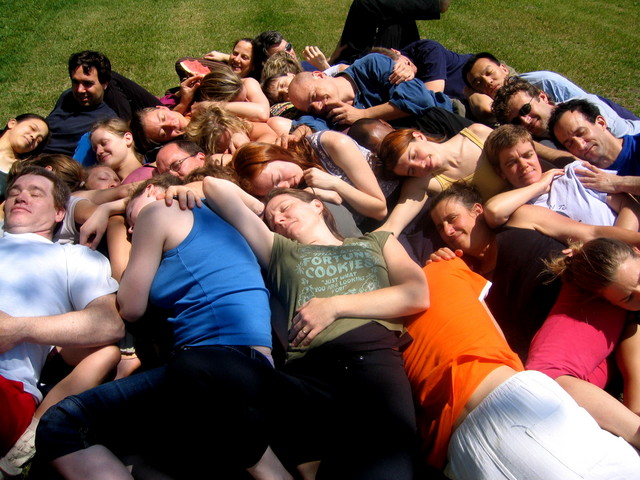
Rhythmic writhing,
Wham! or bam, perhaps, but
No exchange of fluids.
Except sweat
Plentiful sweat
Slick, salty sweat
Who cares?
Everyone shares,
Everyone is present.
Not all dancers are like this
This, this therapeutic acceptance
Of every body
Of experience,
Expertise,
Or lack thereof.
Despite love of movement
Of quietly intense movement,
There’s an attempt to
Give a name to profound, creative, emotions
One feels invited to open up all to all
Wall…..to floor…..to wall…
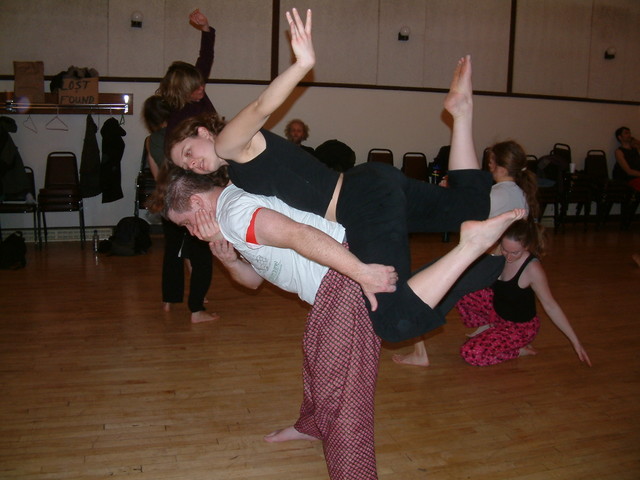
Following a current
Of energy,
A curve, a pop!, a sweep.
An unexpected swerve,
A leap,
One note held long….
Tracing an invisible
Wave length,
A loud thought
An endless torrent
Of noiseless noise
Between bodies
That must make sense
Of something
Or nothing.
Contact.
Physical, visceral, impact, sure.
I found more than Contact.
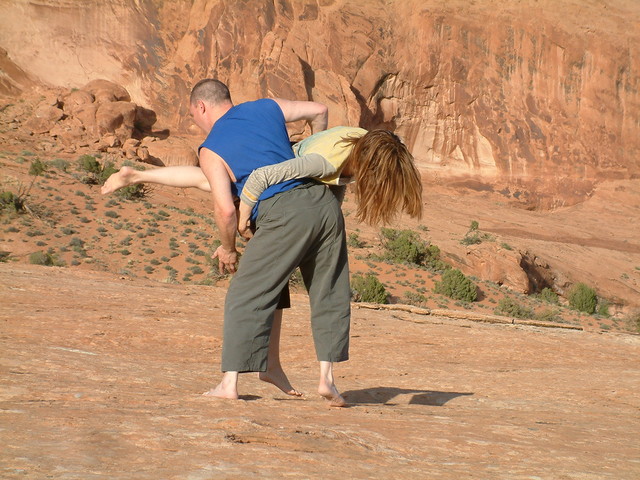 Roots Moment
Roots Moment“Improvisation: the challenge to make decisions in the nick of time, or to risk postponing decisions and spend time in an open moment, in undecided time, to walk the unclaimed/uncultivated terrain between activities, so that decision makes itself, is not wrought up but is guided by an alertness to the forces and emotions at play at the moment – the intensity of light, sound, and movement, and their placement and displacement in space. In this play of forces, a state of mind, an atmosphere and temperature is generated between performer and watcher. This can never be reclaimed – in any case, not with the impact and sharpness of the moment. The challenge is in generating this fullness, not in claiming its final form.” ~~~-Pauline deGroot
top
Workshop Teaching
by Nataraj Hauser
I taught a workshop recently to a group that included contact dancers with 2-3 years of experience as well as people who had never done CI and did not consider themselves dancers. The workshop was one of many offered to a community of around 800 people. The twelve that attended were drawn to my workshop by my entry in the workshop guide. It read: Take your bonfire dance to a new level – literally! Contact improv dance is interactive, free-form dance with an emphasis on dancing in contact with one or more partners. Come learn how to have a dialog in movement. Partners not required. There will be a lot of close physical contact. You might find yourself upside down, so dress appropriately for easy movement.
After a brief introduction, I spoke the by now familiar advice used at the start of our jams when a newcomer shows up: take care of yourself; if you are uncomfortable with something or someone you can say something, disengage, or leave. In this group, I also opted to spell out, plainly, that CI is not sexual in nature and if they were feeling hot-n-bothered with their partner they should acknowledge that feeling and let go of it, perhaps to be pursued later over a cuppa coffee.
Since some of these were people who had never experienced CI, I started with the small dance: Eyes closed, standing loosely, and simply experiencing the tiny movements the body engages in simply to stand there. Next, I encouraged them to lean, ever so slightly, in various directions to experience the next step up in their body’s response. Progressing still further in this tiny dance, I asked them to lean right to the point of tipping in order to learn what their body does as it grasps to maintain control. Finally, I asked them to go to that point, and then ease past it, forcing their body to take a step to avoid a fall, to tip past the point of control. We talked briefly at the end of this and most agreed that it was a little bit scary, and much scarier to fall backward with their eyes closed.
The next exercise was to work in groups of 5-6, in a small circle with one in the middle. The middle person, eyes closed, tipped, allowing his weight to transfer to those in the circle around him. As we rotated people into the middle, I encouraged the ‘catchers’ to avoid using their hands and instead to use other body parts; shoulder, back, chest, hips, legs. Some found it nearly impossible to avoid catching and grasping with their hands. I explained why we avoid holding – it prevents the partner from having her landing gear, feet and hands, available for safety.
The last exercise was to instill a sense of structural strength. We explored the idea of plumb lines, the direct line from point of contact (weight sharing) to the ground. We experimented with using structure to support weight rather than muscle, and I offered several demonstrations of ‘strong’ versus ‘not strong’ body positions.
While the workshop ended there, I was able to offer daily jams for ongoing exploration of contact improv as dance. Each afternoon four to six dancers showed up for ongoing dancing. Also, each morning there was a 10-20 minute period of open dancing prior to a community meeting that attracted several of the dancers. All told, I probably attracted three or four new dancers to the world of contact improv.
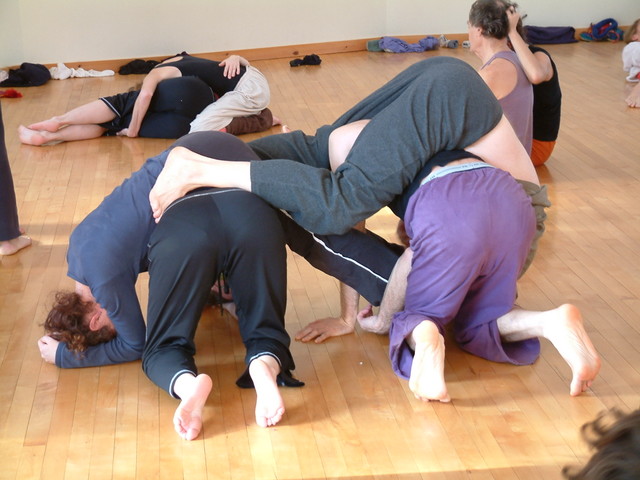
~Nataraj
At this same gathering, there was a Bardic Circle. This was a semi-formal gathering of persons interested in sharing songs, poems, or stories about the experience of the gathering, or merely to showcase a dramatic retelling of an anecdote or historical epic. A genuine interest in fostering an oral tradition of lesson sharing seemed to be at the root of the Circle. I presented the following quickly-penned bit of poetic prose to summarize my week of CI:
giving away our need
Fresh faces, fresh bodies,
Having cautious enthusiasm
Tempered by apprehension.
A short blurb in the
Village guide drew them
Into the hot sun, to me.
No steps no music.
I say and see amused puzzlement
Play across their faces.
“What is up with you?” (*)
My kickoff speech
Is remarkably short (for me).
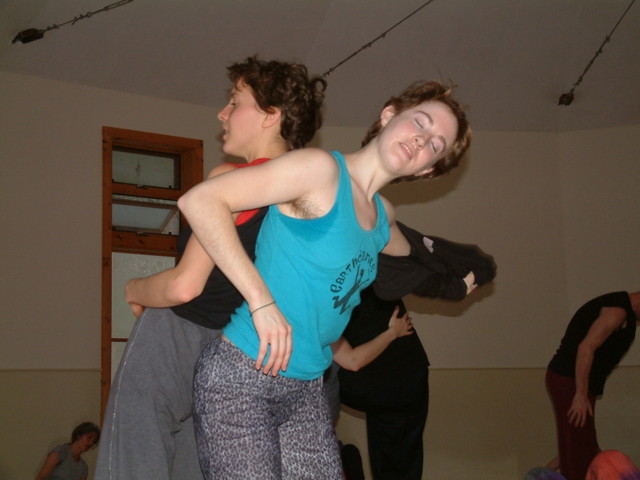
Eyes closed, body still,
The small dance expands the mind.
Feel…feel the tiny motions
That keep the body
From tipping over and
Surrendering to gravity.
Fall forward, fall back,
Learning to savor that moment of
Uncertainty yet now reading
The minute movements
That indicate
A body in motion.
Give weight, take weight.
We explore the deliciousness
Of giving away our need
To control every aspect
Of our gyrations.
Contact improvisation.
Nataraj Hauser, 2006
(*) An oft-heard line from a humerous song sung by one of the bands at the gathering
Mark Zemelman’s new CI site has lots to offer. Check it out!
contactimprov.com
“…sometimes I feel the other dancer wanting me to do something in particular, expecting certain moves and being disappointed if they are not taken. I get very frustrated in dances that have unspoken expectations.” Explore this conversational thread at
contactimprov.tribe.net thread
“dance is a progression of movements, and spaces between movements, where where what happens later agrees in vital ways what happened earlier. (the "agreements" can include "agreeing to disagree".) other activities besides dance have this quality (sports, house building, ceremony, war, ...), but it is at dance's center.
“in choreographed dance, the progressions are in some way designed ahead of time.
“in improvised dance, the progression and its unfolding is discovered along the way.
“in improvised collaborative dance, the partners share the discovery process, together developing their dance as they dance it (and, as it dances them.)
“even more briefly, dance is a container for realizing and growing forms in which enjoyable engagement with movement thrives.
Read more at:
myriadicity.net/Sundry/WhatIsDance
Vancouver's Olivia Thorvaldson Wood
Excerpt from an article boy Rebecca Todd posted at eye.net
At this point, dancing becomes something like a Buddhist meditation practice, allowing dancers to check in with themselves and the world. To dance is to ask: What am I feeling and experiencing right now, in all my senses? How am I dancing with the world and other people around me? For dancers who practise contact improvisation, dancing can be a form of testing principles of physics and biology while remaining in constant dialogue with another person's body. Just as a rock climber has to be attentive to the rock in order not to fall, in contact dance you can't space out -- you have to be awake, or someone gets hurt.
Contact dance is the point of connection between Wood and her improvisation partner, Quinton Bennett. They first danced together at a workshop in Vancouver in 1995, and were intrigued by their differences. Bennett was an expert rock climber who had fallen in love with contact improv. Although Wood hesitates to speak for Bennett, she will say, "I think he's drawn to contact dance because while mountain climbing is about you and the rock, contact is about you and another body. It developed him in more intimate and human ways."
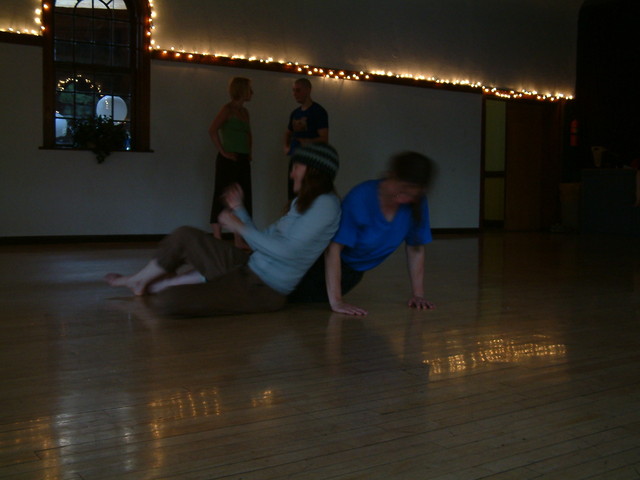
top
from Wikipedia
Contact dance is a type of erotic dance performed in Montréal that fuses elements of lapdancing, flexibility, music, and athletic performance. [woo...now you know!]
Instant invention
Andrew de Lotbinière Harwood's jam session
by WALTER KRAJEWSKI
Jazz musicians don't exactly make it up as they go along. It takes years of experience to be able to respond with elegant style to another musician. And according to Andrew de Lotbinière Harwood, contact improvisation--a form of instantaneous composition based on immediate response to body contact with the other dancer(s)--is the dance equivalent to jazz.
We're all familiar with this to some degree. On any first encounter of the sexual kind, we search for subtle signals, sending our own and awaiting responses. It's the mating dance in which we expose our vulnerability and risk embarrassment and rejection.
Contact improv, as Harwood suggests, also runs on the edge of risk. In his Structured Improvisation, which he performs with Kirstie Simson, they agree upon some parameters, select some music, but then trust their ability to respond to each other's movements. Each watches how the other uses the space and then attempts to use it differently. Each may be in a completely different mood at any moment, setting up a dynamic contrast or complement. They let their bodies talk to each other, running the risk of banal chatter, hoping to make intriguing corporeal statements and achieve flashes of poetry.
Harwood has always been a risk-taker. He started with gymnastics: balancing or swinging on bars, hanging from rings, defying gravity. Harwood the gymnast instantaneously reacted, ever at risk from a false move or a missed contact with solid support. When he passed from gymnastics to yoga, he realized that the "still point" was not for him. His discovery of dance was nothing less than the introduction to an addiction.
Given his own reflex to move, it was only natural for Harwood to question the nature of reflexes. Réflexe (suite) is an ensemble piece based on this exploration. "We have natural reflexes, such as to reach out and touch and to withdraw into self-protection. But beyond the animal instincts, there are also the emotional reflexes we've been taught," he says. "In a relationship, people may become protective, leery about another person and suspicious of their advances. We have to question these emotional reflexes. Do they serve us well? Do they interfere?"
Harwood's current program at Tangente is an overview of the possibilities of the now 25-year-old contact improvisation technique. Réflexe (suite) is specifically structured to offer solo, duet and ensemble sections. In Structured Improvisation, Harwood and Simson present a more typical duet form of risk-taking contact improv. In Hask, on the other hand, Simson takes the gamble as a soloist that, at the moment, the impulse within her body will take flight. If she can snare it, the dance will take hold. If she can't, who knows? But that's the chance, the tension--and the rewarding thrill--of improvisation.
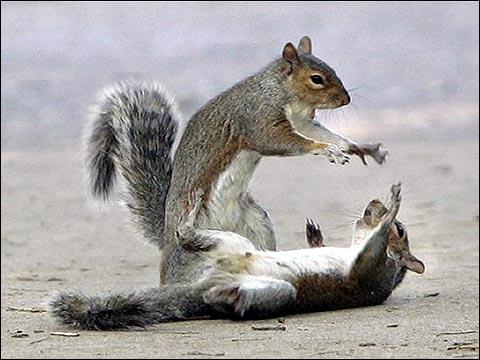 top
top
If you have something you’ve written that you want to get out to our community: An article, a poem, or even just a paragraph you think is important, send it to me and I’ll include it. (nataraj.hauser (at) gmail.com)
One request has been for more photos, so I included a bunch in this issue. If there is something else *you* would like to see, let me know.
Find us online at our Yahoo’s eGroup: Groups.Yahoo.com/group/MadisonContactImprov
AP photo

Click to join MadisonContactImprov